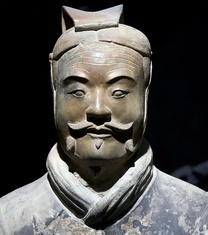
Chinese History 101 #02: Early Imperial China
Last updated: Saturday July 24th, 2021
Report this blog
From where we left off
You can read my first blog on ancient China up to 221 BC. This blog will continue from when Qin conquered the six states and unified China (the blue bit below).
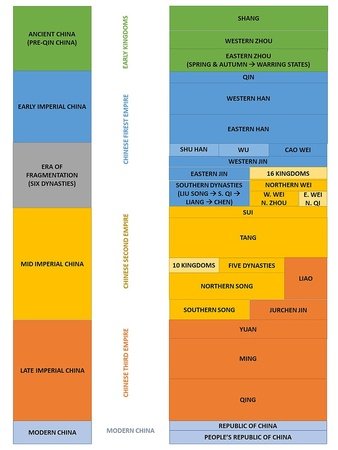
Qin Dynasty (221 BC to 206 BC)
After conquering the other six Warring States, the king of Qin proclaimed himself as the First Emperor of Qin, or Qin Shi Huang. He was a brutal tyrant with a grand vision. He standardised the writing system, measuring units and currency, and ended feudalism by centralising power. He expanded the territory by conquering the southern Yue tribes. He built a massive road network across the country, connected the fragmented defence walls into the Great Wall of China. He was notoriously known for crushing oppositions by burning books and burying scholars alive. He was obsessed with acquiring immortality and desperately sought the fabled elixir of life, while secretly constructed a city-size mausoleum for himself guarded by the famous Terracotta Army.
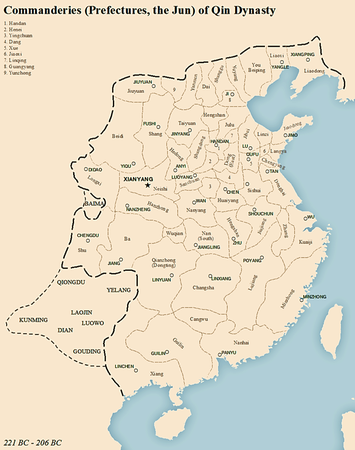
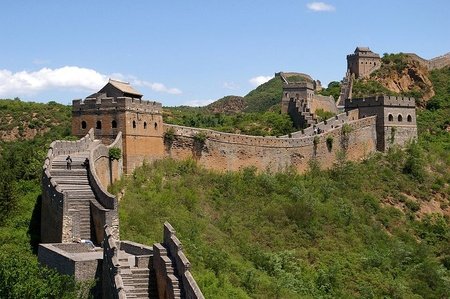

But his vision of eternal rule did not work out and the Qin dynasty fell apart very quickly after his death. Uprising and rebellion broke out, and numerous pretenders from the former six states revolted. Amongst them, the most powerful one was Xiang Yu, a general from the former Chu state. But the Qin dynasty ended when another rebel force led by Liu Bang (pronounced like "bound", not "bang") entered the capital Xianyang and the Qin third emperor Ziying surrendered.
Although the Qin dynasty greatly influenced China, and is thought to be the origin of the European name for China, it in fact only lasted for 15 years.
Chu-Han Contention (206 BC - 202 BC)
Liu Bang treated Ziying respectfully and promised to protect civilian lives and properties. However, Liu Bang's troop were outnumbered by Xiang Yu's who later arrived and seized control of the city. Xiang Yu executed Ziying, his troop plundered the capital and burnt down the palace.
Xiang Yu was upset with Liu Bang dethroning Qin, and heard rumour that Liu was planning to declare himself king. The power struggle between them was highlighted in the story of the Feast at Swan Goose Gate, a banquet held by Xiang with Liu as a guest. Xiang Yu's advisor strongly suggested to kill Liu Bang during the banquet, but Liu Bang played dumb and sucked up to Xiang Yu. Liu Bang then escaped by pretending drunk and went to toilet and never returned.
Xiang Yu declared himself "Hegemon-King of Western Chu". He set up 18 kingdoms, settled Liu Bang in the remote southwestern corner and gave Liu a title of "King of Han" (named after the capital Hanzhong in the middle of the Han River), while he controlled a large part in the east.
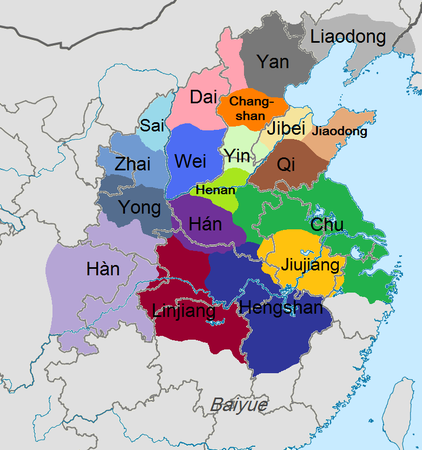
The eighteen kingdoms were short-lived. Liu Bang soon conquered the other kingdoms and starting the Chu-Han Contention. Following many battles and changing alliances, the Han defeated the Chu and Xiang Yu committed suicide at the end. Liu Bang declared himself the first Emperor of the Han dynasty in 202 BC.
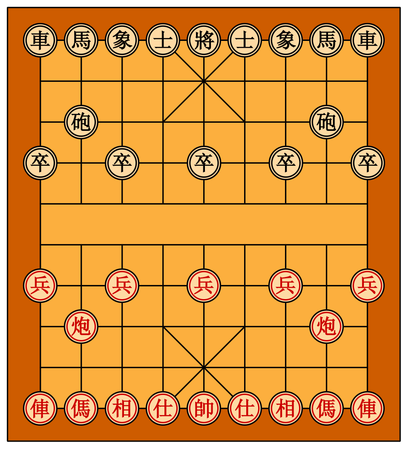
Western Han Dynasty (202 BC - 9 AD)
Similar to the Zhou dynasty, the first part of the Han dynasty is historically called the Western Han, as its capital Chang'an (today Xi'an) was located in the west. After few hundred years of wars since the Eastern Zhou, the country finally enjoyed peace and stability. However, the nomadic Xiongnu in the north frequently raided past the Great Wall, despite the Han trying to make peace by sending large amounts of tribute items such as silk, food and wine to the Xiongnu, and marrying their princesses up north.
By the time of Emperor Wu in 133 BC, the Han finally had enough and launched massive invasions of Xiongnu and drove them north of the Gobi desert. Emperor Wu also dispatched his diplomat Zhang Qian to explore Central Asia. Zhang Qian visited Fergana, Sogdiana, and Bactria (formerly the Greco-Bactrian Kingdom), and reported on Indo-Greek Kingdoms, Parthian Empire and Seleucid Empire in Mesopotamia. His trip created the Silk Road connecting the East to the West.
Emperor Wu also expanded the Han's territory by annexing Nanyue in the south, Dian Kingdom in the southwest, and Gojoseon in the northeast. The Han dynasty is considered a golden age in Chinese history. The Chinese ethnic group refers to themselves as the "Han people", the language as "Han language", and written Chinese as "Han characters" (or kanji in Japanese).
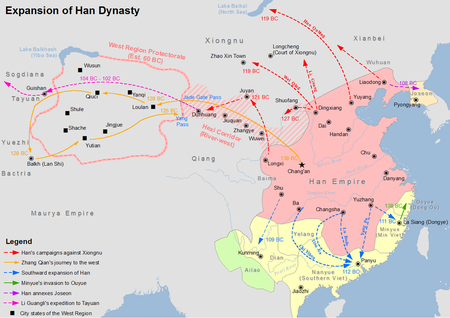
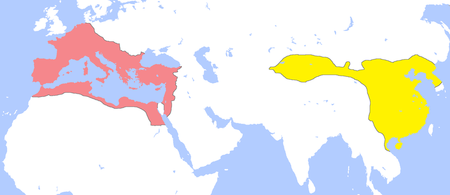
One interesting thing about the Western Han was that most emperors were rumoured to be gay or bisexual. The most prominent one was Emperor Ai (reign between 7 BC to 1 BC), whose relationship with his male consort was given the term "passion of the cut sleeve", after a story that one afternoon while napping, Emperor Ai cut off his sleeve rather than disturbed his sleeping lover when he had to get out of bed. In Chinese idiom, "cut sleeve" is equivalent to modern day "Brokeback".
The fall of the Western Han came when a consort kin (i.e. queen's relative) Wang Mang took over and established the short-lived Xin dynasty (9 AD - 23 AD). Natural disasters and widespread famines soon broke out. Desperate peasants turned bandits allied with discontented nobles and descendants of the former imperial clan revoked, which turned into a large-scale civil war by 19 AD.
Eastern Han Dynasty (25 - 220 AD)
By 25 AD, Liu Xiu, a descendent of Han imperial family, defeated various rebel armies and other rival claimants, and was crowned emperor in Luoyang, restoring the Han dynasty which is known as the Eastern Han. In its first 60 years, it regained lost territories, reconnected with external empires and entered another golden era. Papermaking was invented, and foreign travellers including Buddhist monks visited China and translated works into Chinese.
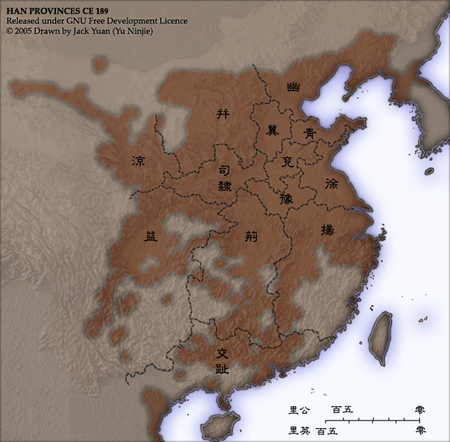
However, by the mid to late period, the Eastern Han suffered from a vicious cycle of violent power struggles between the palace eunuchs and the various consort clans. In 184 AD, massive peasant revolt broke out and was crushed with help from the warlords. One of the warlords, Yuan Shao, besieged the palace and massacred 2000 eunuchs, while another warlord Dong Zhuo invaded the capital and set up Emperor Xian and killed the 15 year-old former emperor. Yuan initiated a coalition of warlords against Dong, who burnt down Luoyang and fled to Chang'an with Emperor Xian. During the chaos, Emperor Xian escaped back to the ruin of Luoyang, only to be held hostage by another warlord Cao Cao, who eventually defeated Yuan and other warlords and unified the north.
By 208 AD, Cao Cao was ready to unify the country and conquered the southern warlords. In the Battle of Red Cliffs, fictionised in the classic novel Romance of the Three Kingdoms, the much larger army of Cao Cao suffered crushing defeat at the Yangtze River in one of the largest naval battles in history. After that, China was divided into three spheres of influence, with Cao Cao in the north, Sun Quan in the southeast and Liu Bei in the southwest.
The Eastern Han formally ended after Cao Cao's death, when his son forced Emperor Xian to abdicate in 220 AD, and China entered the Three Kingdoms period.
The end of the second blog
I was overly ambitious trying to cover all the history from Qin to Sui in one blog but only managed to do half. So the next blog will start from the Three Kingdoms until the start of the Sui dynasty (the grey bit on the left of the top chart).
If you like period drama, you can watch White Vengeance (2011) featuring the Feast at Swan Goose Gate, or Red Cliff (2008) featuring the Battle of Red Cliffs. Otherwise, there is the latest Romance of the Three Kingdoms XIV video game.
Please comment on what you think of these blogs, whether these are too long, too detailed or too confusing. Feel free to ask me questions and thanks again for reading.

I don't have much more to add. Definitely looking forward to the more modern stuff (Opium Wars, Taiping and Boxer Rebellions, Chinese Civil War Era), but I enjoyed this too!
For the modern history, you'll have to wait for 4 or 5 more blogs before I reach the 19th century.